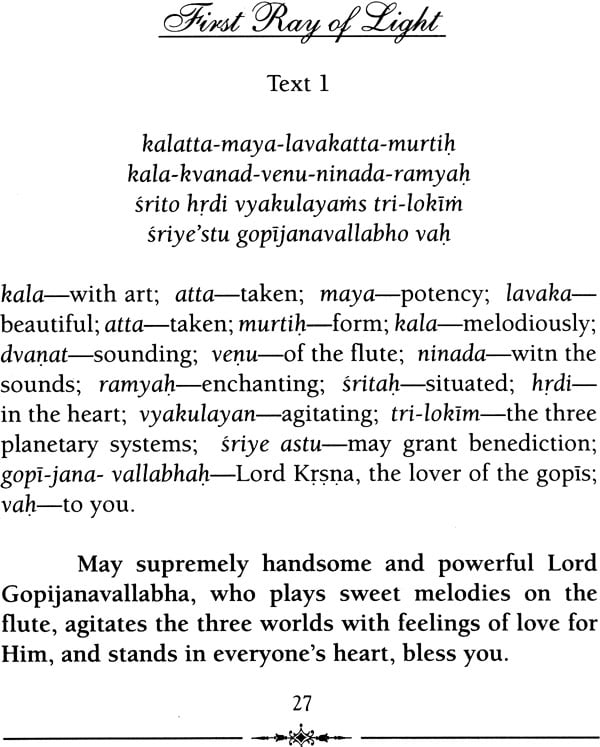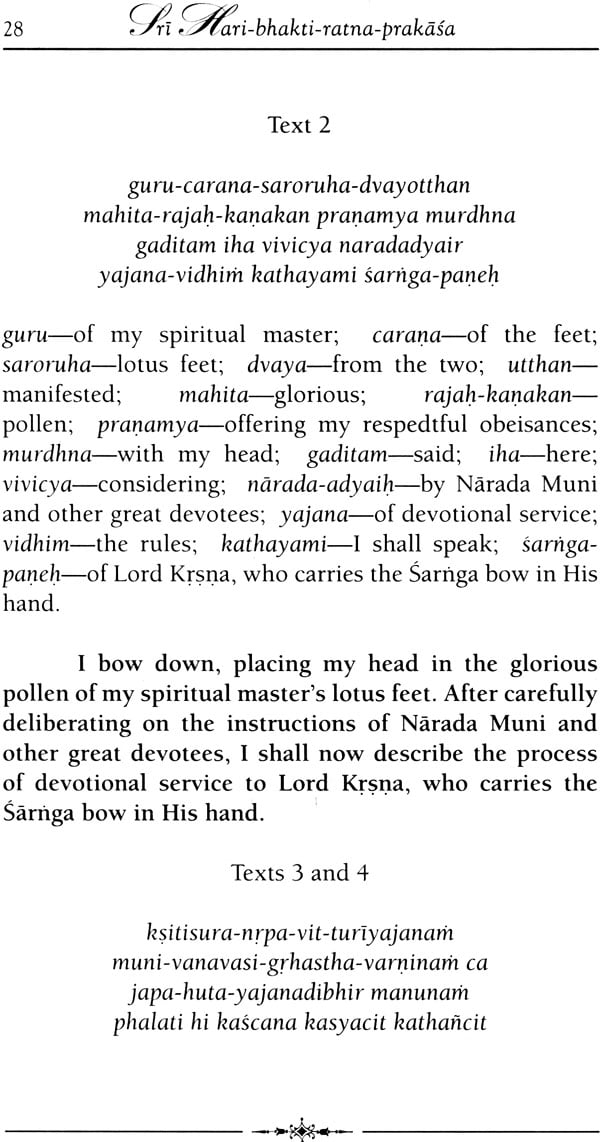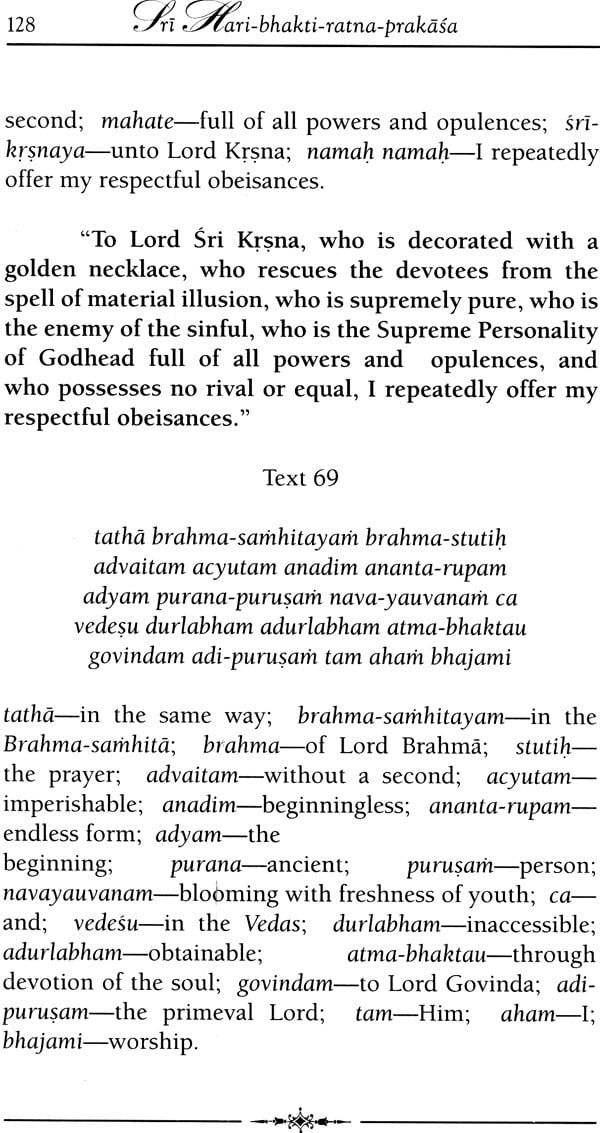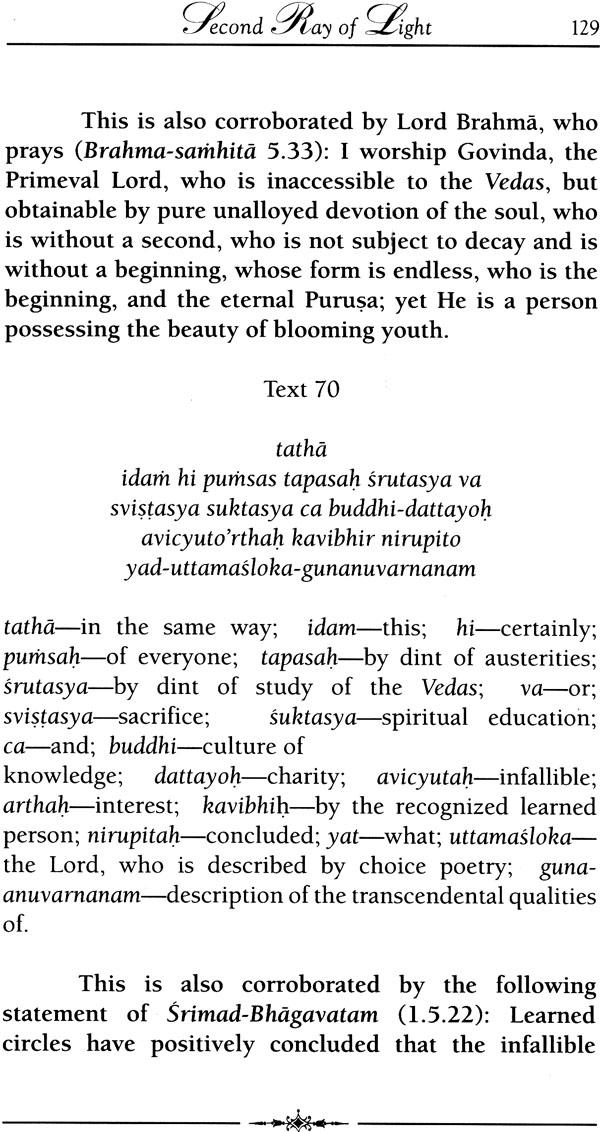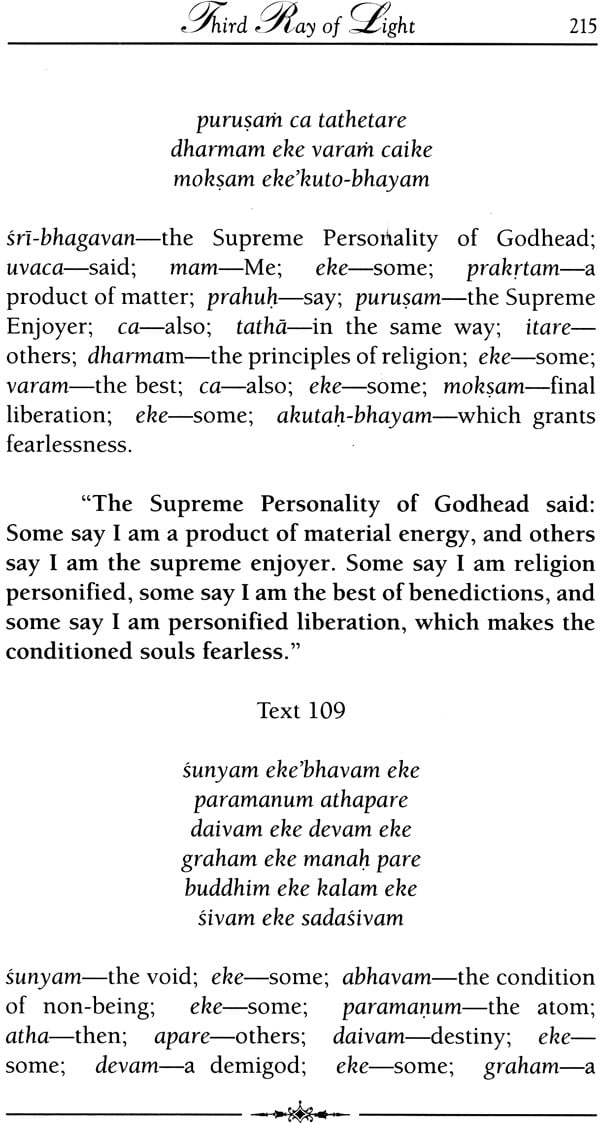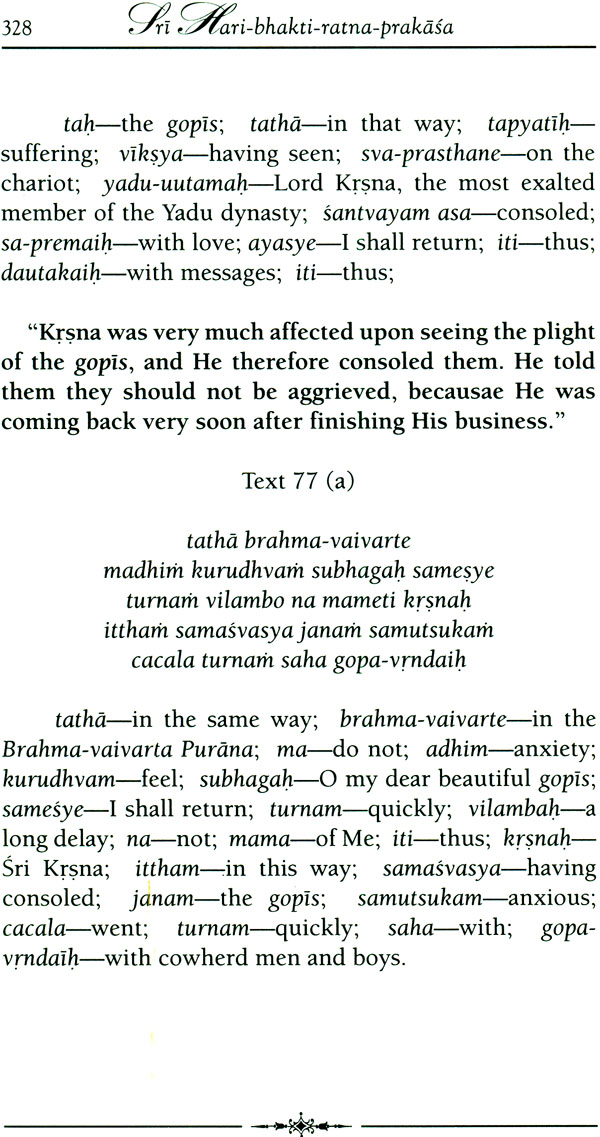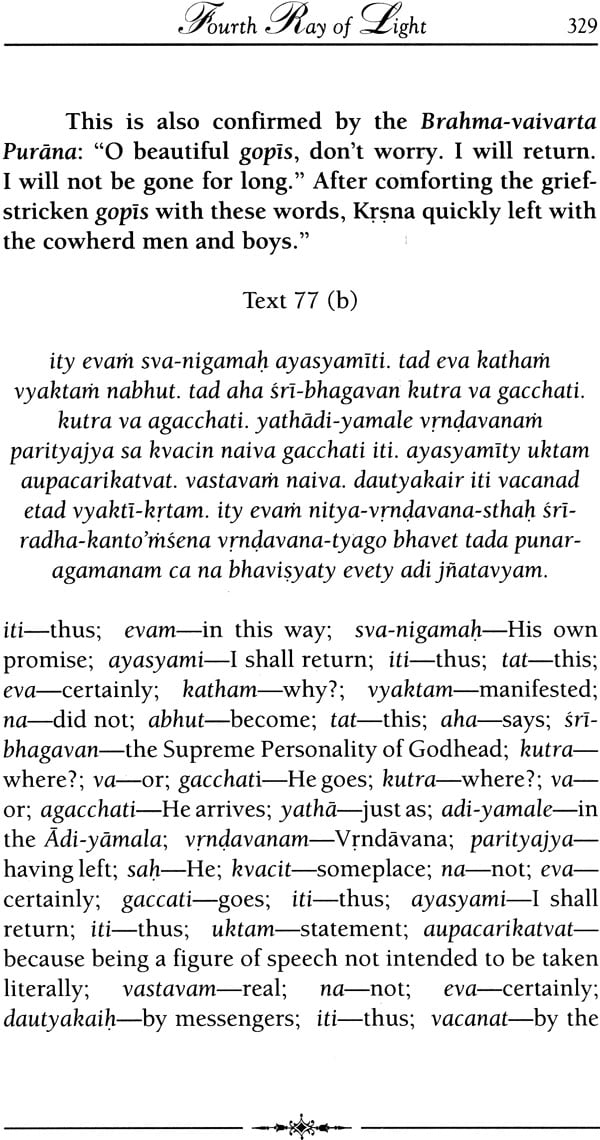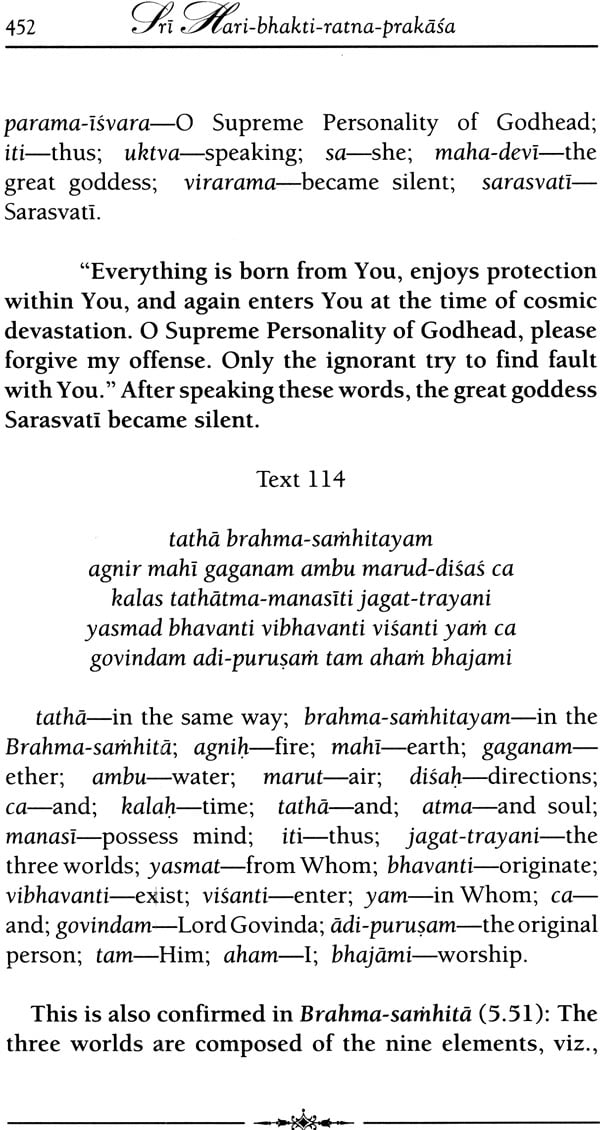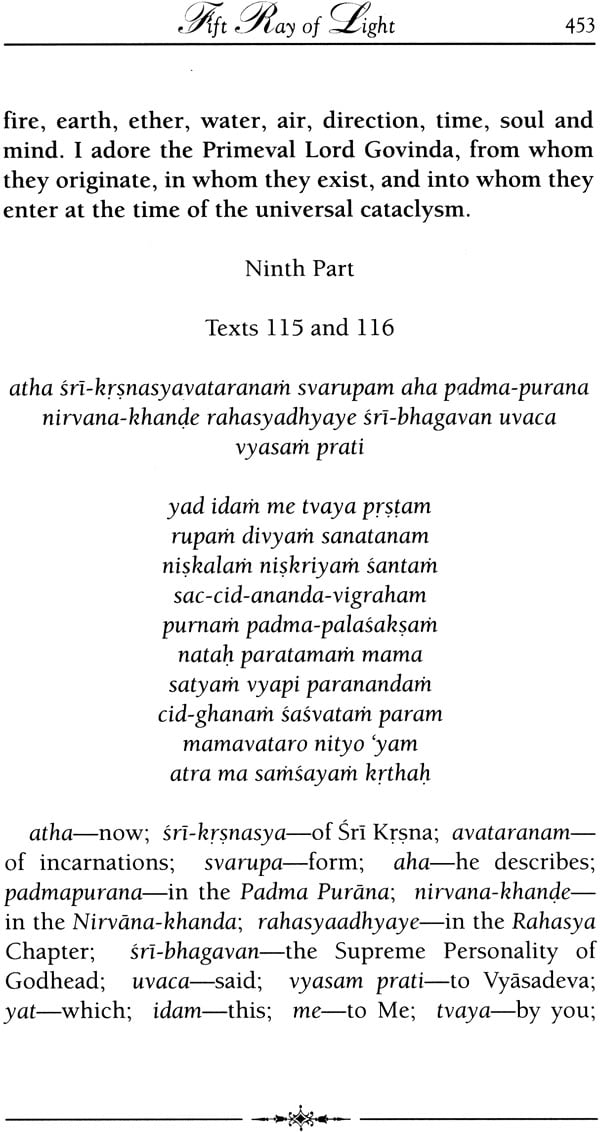
The Splendor of the Jewel of Hari Bhakti
Book Specification
| Item Code: | NAN882 |
| Author: | Sri Raghava Pandita Gosvami |
| Publisher: | RAS BIHARI LAL AND SONS |
| Language: | Transliteration and Word-to-Word Meaning English Translation |
| Edition: | 2009 |
| ISBN: | 9788184030099 |
| Pages: | 545 (7 B/W Illustrations) |
| Cover: | Hardcover |
| Other Details | 9.0 inch X 6.0 inch |
| Weight | 820 gm |
Book Description
This book describing devotional service to Lord Hari’s lotus feet is a splendid, pure diamond that illuminates the darkness in the hearts of all living entities. O intelligent reader, please accept this diamond as your earring.
O thoughtful reader, please continually hear the instructions that I, Raghava Gosvami, present in this book.
Introduction
In the Bhakti-ratnakara of Narahari Cakravarti it is said that Sri Raghava Pandita belonged to a Kulina brahmana family of South India, and he always very merciful to the poor. He wrote several books, including Hari-bhakti-ratna-prakasa. Raghava Gosvami was an authority in all sastras. He resided at Govardhana, and when Srinivasa Acarya and Narottama dasa Thakura came to Vrndavana, he guided them on a tour of all the holy places, beginning with Mathura.
It is stated in Gaura-ganoddesa-dipika: "That person who was Sakhl Campakalata, the life of SrimatiRadharani in Vraja, has appeared as Sri Raghava Gosvami, the resident of Govardhana, in Gaura-lila. He has written a book called Hari-bhakti-ratna-prakasa."
In the tenth chapter of the Adi-Illa of Sri Caitanya- caritamrta, it is said: Raghava Pandita, Lord Sri Caitanya Mahaprabhu's original follower, is understood to have been the seventh branch. The foods Damayanti cooked for Lord Caitanya when He was at Puri were carried in bags by her brother Raghava without the knowledge of others. The Lord accepted these foods throughout the entire year. Those bags are still celebrated as raghavera jhali (the bags of Raghava Pandita).
In the Madhya-liIa of Sri Caitanya-caritamrta, it is described how Lord Caitanya had bid farewell to the devotees who had come to Jagannatha Puri from Bengal. There it is said: Sri Caitanya Mahaprabhu next spoke some relishable words to Raghava Pandita: "I am obliged to you due to your pure love for Me."
Then addressing all the assembled devotees, the Lord said: "Just hear about the pure devotional service rendered to Krsna by Raghava Pandita. Indeed, Raghava Pandita's service is supremely pure and highly accomplished. Apart from other commodities, just hear about his offering of coconuts. A coconut is sold at the rate of five ga~4iis each. Although he already has hundreds of trees and millions of fruits, he is still very eager to hear about the place where sweet coconuts are available. He collects coconuts with great endeavor from a place twenty miles away, and he pays four panas each for them."
"Every day five to seven coconuts are clipped and put into water to keep cool. At the time of offering bhoga, the coconuts are again clipped and cleansed. After holes are made in them at the top, they are offered to Lord Krsna. Lord Krsna drinks the juice from these coconuts, and sometimes the coconuts are left drained of juice. At other times the coconuts remain filled with juice."
"When Raghava Pandita sees that the juice has been drunk from the coconuts, he is very pleased. He then breaks the coconuts, takes out the pulp and puts it on another plate. After offering the pulp, he meditates outside the temple door. In the meantime, Lord Krsna, having eaten the pulp, leaves the plate empty. Sometimes, after eating the pulp, Krsna fills the plate again with new pulp. In this way, the faith of Raghava Pandita increases, and he floats in an ocean of love."
"One day it so happened that about ten coconuts were properly clipped and brought by a servant to offer to the Deity. When the coconuts were brought, there was little time to offer them because it was already late. The servant, holding the container of coconuts, remained standing at the door. Raghava Pandita then saw that the servant touched the ceiling above the door and then touched the coconuts with the same hand. Raghava Pandita then said, 'People are always coming and going through that door. The dust from their feet blows up and touches the ceiling. After touching the ceiling above the door, you have touched the coconuts. Now they are no longer fit to be offered to Krsna because they are contaminated.' Such is the service of Raghava Pandita. He did not accept the coconuts but threw them over the wall. His service is purely based on unalloyed love, and it conquers the whole world."
"Thereafter, Raghava Pandita had other coconuts gathered, cleansed and clipped, and with great attention he offered them to the Deity to eat. In this way, from distant villages he collects excellent bananas, mangoes, oranges, jackfruits and whatever other first-class fruits he has heard about. All these fruits are collected from distant places and bought at a high price. After trimming them with great care and purity, Raghava Pandita offers themto the Deity. Thus with great care and attention Raghava Pandita prepares spinach, other vegetables, radishes, fruits, chipped rice, powdered rice and sweetmeats. He prepares cakes, sweet rice, condensed milk and everything else with great attention, and the cooking conditions are purified so that the food is first class and delicious."
"Raghava Pandita also offers all kinds of pickles, such as ksamdi. He offers various scents, garments, ornaments and the best of everything. Thus Raghava Pandita serves the Lord in an incomparable way. Everyone is very much satisfied just to see him."
Sri Caitanya Mahaprabhu then mercifully embraced Raghava Pandita.
As expected, it was a great transcendental pleasure to go through this wonderful translation by Kusakratha Prabhu. Everything he touches is permeated with a wonderful pure devotion that is devoid of pride and filled with great affection for Radha and Krsna.
This book, Hari-bhakti-ratna-prakasa, contains some gems of wisdom, and some information not to be easily acquired elsewhere. Here are three verses that fascinated me:
"In the Varaha-samhitii Lord Varaha says: The individual jiva souls are billion-billionth parts of the blissful nectarean rays of light shining from the dark- complexioned form of the Supreme Lord."
"The flowers' great variety of fragrances come from the touch of a millionth part of a fragment of the Divine Couple's charming transcendental forms. Lord Krsna's original potency is His beloved Radhika. From a trillionth part of a fraction of Her effulgehce are manifested Durga- devi and other demigoddesses in this world of three modes."
"If one sells or gives in charity a cow, he does not give or sell himself. In the same way one may give his body, possessions, or many other things to lord Krsna, but refrain from giving himself."
Here is certainly a highly-appreciated addition to anyone's collection of Vaisnava literature.
Contents
| First Ray of Light | 27 |
| The author first establishes that Lord Krsna is the Supreme Personality of Godhead, the master of the demigods. He refutes the common notion that all gods and goddesses are equal. He then establishes that devotional service unto Lord Krsna is the actual path of auspiciousness recommended by the Vedic literature. Many quotations from the scriptures are given to support these conclusions. | |
| Second Ray of Light | 61 |
| First Part. | 61 |
| Here is more evidence that worship of the demigods produces temporary results, whereas worship of the Supreme Lord awards one eternal residence in His abode. | |
| Second Part. | 73 |
| After discouraging demigod worship, the author next provides evidence that impersonal liberation is rejected by those who taste the eternal happiness of service the Lord's lotus feet. | |
| Third Part | 80 |
| Here objections that because Lord Krsna appears within the temporary material world, His body must also be material, are countered. Next, the arguments of the impersonalists are vividly presented and then countered by sound evidence from the scriptures. | |
| Fourth Part | 97 |
| The conception that the Lord's body is made of material elements is thoroughly discussed and that His body is fully spiritual is established by many quotes from the scriptures. | |
| Fifth Part | 104 |
| It is the personal form of the Lord and not the Brahman effulgence that is to be worshiped. To support this conclusion, the story of jabali Muni is given. | |
| Sixth Part | 121 |
| Concluding arguments to counter the impersonalists' contention that the Absolute is ultimately impersonal and formless. | |
| Third Ray of Light | 133 |
| First Part. | 133 |
| In this section, the author provides evidence that Sri Krsna is perfect and complete, that He is superior to all, that His form is full of bliss, that He eternally resides in Vrndavana, and that He is Sri Radhika's beloved. | |
| Second Part. | 141 |
| Here it is conclusively established that the Lord's body is not material and not different from His self. The Lord is also not different from His potencies, of which Radha is the chief. Radha is not different from Krsna. The author cites the scriptures' explanation that Radha was born from half of Krsna's body. | |
| Third Part | 150 |
| Consisting of only one verse, this part explains why Krsna's body is blackish. | |
| Fourth Part | 151 |
| Here the objection that because everything in this world is destroyed, Krsna's body cannot be called eternal, is addressed. In the course of this discussion, the locations of the various planetary systems are given, as are the units of time and the ten kinds of air within the body. The conclusion is that Krsna's body is not under the jurisdiction of time and therefore eternal. | |
| Fifth Part | 163 |
| In this part, the abode of the Lord, Vmdavana, is discussed. There are two Vmdavanas, Nitya-Vrndavana and Divya- Vrndavana. Nitya- Vrndavana appears on this earth planet, and Divya-Vrndavana shines above all the worlds. Just as Krsna is eternal, so is His abode, Vrndavana. Here it is established that everything in existence is manifested from the splendor of Krsna's transcendental body. | |
| Sixth Part | 183 |
| This part establishes that Lord Krsna is the original Supreme Personality of Godhead and Lord Matsya, Lord Kurma, and the other incarnations are expansions of His expansions. | |
| Seventh Part | 194 |
| This section relates how in the Brhad- vamana Purdna, Vrndavana-mahatmya, Sri Krsna revealed His abode, Vrndavana, to the personified Vedas. | |
| Eighth Part | 202 |
| This part establishes that ther is nothing superior to the form of Sri Krsnacandra by relating a conversation between Srirnati Rukmini-devt and Sri Krsna found in the Sri Krsna-yamala. | |
| Ninth Part | 211 |
| Here is presented the revelation of Sri Krsna to Sanat- kumara, as found in t e Padma Puriir.ta, Nirviir.ta-khar.tda. The various ages of ord Krsna are described in the course of this discussion. Various forms of Lord Visnu are described as the gatekeepers of Krsna's supreme abode. | |
| Fourth Ray of Light | 239 |
| First Part. | 239 |
| This part establishes that the original, perfect, and complete Personality of Godhead is Sri Krsna, the son of Maharaja Nanda. | |
| Second Part. | 247 |
| Here the question is addressed, "If Sri Krsna eternally stays in Vrndavana, then why has He taken birth?" The answer is that He appears of His own free will, and not like an ordinary conditioned soul. | |
| Third Parth | 251 |
| From the Brhad- Viimana Puriina, Vrndavana-rajo- mahatmya, there is a description of how Lord Krsna fulfilled the desire of the personified Vedas to become gopfs in Vmdavana. Here, the five groups of gopfs are described. Then, the doubt that Lord Krsna appeared from the womb of His mother is dispelled. The understanding is that Vasudeva- Krsna is an expansion of Vraja-nandana Krsna, so that it was a Visnu form that appeared as the son of Devaki. | |
| Fourth Part | 261 |
| Here the illusory story of Krsna and Balarama appeared from a black and white hair of Ksirodakasayi Visnu is clarified. | |
| Fifth Part | 271 |
| In this part, the question, "If the Supreme Personality of Godhead's birth is not factual, then why did He manifest the pastimes of being a child?" The answer is that He did so for the pleasure of His devotees. In this connection, the story of Sucisrava and Surarca from the Sammohana- tantra is related. | |
| Sixth Part | 278 |
| Here the question is raised, "If the Lord is equal to everyone and thus not partial, then why did He kill so many demons, such as Putana, Sakatasura, Trnavarta, Aghasura, and Bakasura?" The answer given by the author is that Lord Krsna did not kill anyone, because such killing was done by His Visnu expansion. Next, Krsna's ages are discussed and it is concluded that the kaiSora form is His original feature. | |
| Seventh Part | 292 |
| This section explains that Vmdavana is the best of all the Lord's abodes. It is there that Krsna appears· in His kaiSora form, whereas in Gokula He manifests His childhood form, and in other places He manifests various other forms. Thus, Vrndavana, however is superior to Gokula. | |
| Eighth Part | 304 |
| Here the question is raised, "You say that Krsna never leaves Vrndavana, then why is it said that He goes to Mathura and other places?" The answer is that, "Lord Krsna eternally remains in Vrndavana in His kaiSora form, but His plenary expansions may leave Vrndavana and go to other places." Next, quoted from the Ndrada-paiicardtra, Goddess Durga elaborately describes the unique loveliness of Lord Krsna as a youth in Vrndavana. | |
| Ninth Part | 315 |
| This part continues to describe the incomparable beauty of Krsna in Vmdavana, which references to many scriptures. The this doubt is discussed: "If Krsna eternally resides in Vrndavana, then why did the residents of Vrndavana see Him depart for Mathura?" The answer is that Sri Krsna's form eternally remains in Vmdavana, although sometimes it is visible to the people in general, and sometimes not visible to them. The author concludes by saying, "Krsna, the lover of Sri Radha, eternally stays in Vmdavana, and it is His plenary Visnu form of Lord Vasudeva who travels to Mathura. If He never left Vrndavana, then He will also never return. This should be understood. | |
| Tenth Part | 325 |
| Here in the course of the discussion of Sri Krsna's eternal residence in Vrndavana, the classification of gopis is revealed. | |
| Eleventh Part | 330 |
| It is said that some of the residents of Vrndavana see Krsna perpetually. Some may object: "If Sri Krsna remains eternally in the range of the vrajavasis' perception, then why did He send Uddhava to Vmdavana to console the gopis in their grief of separation from Him?" The answer is given: "This description of the gopis being separated from Krsna does not apply to the gopis who are potencies expanded from the Lord's transcendental body, or to those who are the Lord's eternal associates, or to those who had been personified Vedas or great sages. This description of the gopis feeling separation from Lord Krsna applies only to those gopis who had been daughters of the demigods." | |
| Fifth Ray of Light | 343 |
| First Part. | 343 |
| Here Lord Krsna's expansions are described in terms of perfect, more perfect, and most perfect. There is also a description of the forms of Brahma, Visnu, and Siva in terms of the three modes of material nature. | |
| Second Part. | 376 |
| In this part is a discussion of the symbols found on Lord Krsna's lotus feet, whe ein it is revealed that only some of these symbols are found on the feet of other extraordinary personalities. | |
| Third Parth | 387 |
| Here the various classes of incarnations of the Lord are described in terms of their relative prowess. This part also contains a description of how Sri Radha was manifested from half of Lord Krsna's body, as described in the Govinda- Vrndavana-sastra. | |
| Fourth Part | 401 |
| After hearing that Radha is the original potency of the Lord, someone may question, "Goddess Durga is famous everywhere as the original potency of the Supreme Personality of Godhead. Why do you say that a different person is that original potency?" The answer is given, "The Lord's beloved Radhika is His dear original potency. Durga and the other goddesses in the world of the three modes are a million-millionth part of a part of Her." Indeed, Radha and Krsna are not different. | |
| Fifth Part | 405 |
| Here is a description of how the Lord's potencies aredivided into three broad categories, kriya-sakti, iccha- sakti, and jnana-sakti. | |
| Sixth Part | 414 |
| The abodes of Lord Vasudeva, Sankarsana, Pradyumna, and Aniruddha are herein described. Rukrninl, Satyabhama, Nagnajiti, Sulaksmana, Mitravinda, Sundanda.jambavati, and Susila are listed as the eight principal queens of Lord Vasudeva. Next is the story from the Puranas of how Laksml became a golden line on the Lord's chest. | |
| Seventh Part | 430 |
| This part gives more evidence that Lord Visnu, Maha- Visnu, Brahma, Siva, Matsya, Kurma, and all other Deities are all either amsa, kula, kala, or saktyavesa expansions of the Supreme Personality of Godhead, Sri Krsna, the lover of Sri Radha. | |
| Eighth Part | 441 |
| The question is raised: "If Sri Krsna is the original Supreme Personality of Godhead and has no duty He must perform, then why does He incarnate in various forms on the earth?" In answer, many incarnations of the Lord are listed and the missions They performed. All of these incarnations are expansions of Lord Krsna, who is not obliged to do anything. | |
| Ninth Part | 453 |
| Further confirmation of the truth that Sri Krsna is the form in which all incarnations of Godhead rest. Thus there is no other personality who is equal to or superior to Lord Krsna. | |
| Sixth Ray of Light | 465 |
| First Part. | 465 |
| Here, devotional se ce at Lord Krsna's lotus feet is described in three divisions: sadhana-bhakti, jnananvita- bhakti, and prema-bhakti. Hearing is said to be the root of all the nine parts of devotional service. One by one, each of the nine processes is discussed, and in this part, hearing and chanting are explained. | |
| Second Part. | 477 |
| This part deals with smaranam, or remembering the Lord, and pada-sevanam (serving the Lord's lotus feet). | |
| Third Parth | 486 |
| Here offering obeisances to the Lord is described. These first six processes of devotional service are considered to be within the category of sadhana-bhakti. | |
| Fourth Part | 490 |
| Here dasyam (rendering service to the Lord), sakhyam (thinking of the Lord as one's friend), and atma-nivedanam (surrendering everything to the Lord) are described as the three activities of jiiananvita-bhakti. It is then said: "If I cannot see my Lord, who is more dear to me than my own breath, then this life is actually death." This is called prema. | |
| Fifth Part | 506 |
| The question is asked, "How is devotional service attained?" The answer is that devotional service is only achieved by the association of pure devotees of the Lord. | |
| Sixth Part | 512 |
| Here it is asked, "What is the nature of the Lord's devotees?" In answer it is said, "The mahatmas are equipoised. They do not see any difference between one living entity and another. They are very peaceful and are fully engaged in devotional service. They are devoid of anger, and they work for the benefit of everyone. They do not behave in any abominable way. Such people are known as mahatmas." The nature of pure devotional service is also discussed. | |
| Seventh Part | 520 |
| Although the Lord has commanded that one should give up all varieties of religion and surrender to Him alone, someone might say, "Still, by not performing pious activities and religious rituals, the devotees are at fault." This idea is refuted by evidence from the scriptures. | |
| Eighth Part | 529 |
| The book ends with the author's plea to his readers, "Please abandon demigod worship, breath control, ordinary religion, pious deeds, charity, pilgrimages, austerities, vows, and Brahman worship. Worship the two lotus feet of Sri Krsna, the imperishable Supreme Personality of Godhead, who grants transcendental bliss." | |
| Our Other Publications | 541 |
Sample Pages
